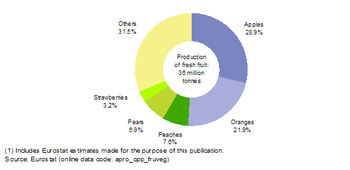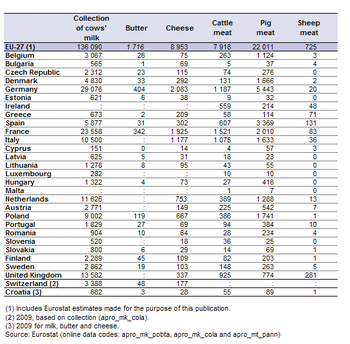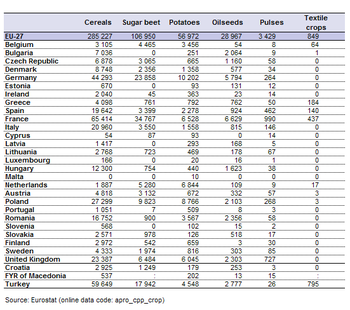Data from September 2011, most recent data: Further Eurostat information, Main tables and Database.
There is a wide diversity of natural environments, climates and farming practices across Europe that feed into a broad array of food and drink products for human consumption and animal feed, as well as providing inputs for non-food processes. Indeed, agricultural products form a major part of the cultural identity of Europe's people and regions.
With this in mind, European Union (EU) legislation has been developed to protect particular food and drink product names which are linked to a specific territory or a specific production method, aiming to provide guarantees as to the origin and authenticity of a range of products.

(2000=100) - Source: Eurostat (apro_cpp_crop)

(%, based on tonnes) - Source: Eurostat (apro_cpp_crop)

(%, based on tonnes) - Source: Eurostat (apro_cpp_fruveg)

(%, based on tonnes) - Source: Eurostat (apro_cpp_fruveg)

(1 000 tonnes) - Source: Eurostat (apro_mk_pobta), (apro_mk_cola) and (apro_mt_pann)
Main statistical findings
Crops
In 2010, the EU-27 produced 285.2 million tonnes of cereals (including rice). Despite the vagaries of the weather, cereal production in the EU-27 was relatively stable between 2000 and 2010 (see Figure 1), albeit with notably higher harvests in 2004 and 2008. The production of cereals fell from the relative high recorded in 2008 with production falling by 6.1 % in 2009 and a further 3.6 % in 2010. Nevertheless, the production of cereals within the EU-27 remained 2.6 % higher in 2010 than it had been in 2000.
There was a large overall increase (49.9 %) in the production of oilseeds between 2000 and 2010. On the other hand, the output of potatoes declined steadily during the last decade (with production falling by 31.2 % between 2000 and 2010). The production of sugar beet also fell over the last decade (-21.9 %), with all of the losses taking place during the second half of the decade, with output contracting considerably in 2006 and again in 2010.
An analysis of the most recent developments, based on a comparison between 2009 and 2010, shows that EU-27 production of cereals fell by 3.6 %. Sugar beet and potatoes production decreased by 6.3 % and 9.0 % respectively, while there was a small increase in the production of oilseeds (0.7 %).
France and Germany were by far the largest cereal, sugar beet and oilseed producers, together accounting for 54.8 % of the EU-27’s sugar beet production, 42.9 % of its oilseeds production and 38.5 % of its cereal production in 2010 (see Table 1). The production of potatoes was more widely spread across the EU Member States, with Germany recording the highest level of production (17.9 % of the EU-27 total in 2010), while Poland, the Netherlands, France and the United Kingdom each accounted for between 15.4 % and 10.6 % of the total. France was, by far, the leading producer of pulses and textile crops in 2010.
Figure 2 presents a breakdown of the production of cereals in the EU-27 in 2010. Almost half (47.8 %) of the total production of cereals was accounted for by wheat, while around one fifth of the total was composed of grain maize (20.0 %) and barley (18.7 %); rice production in the EU-27 was considerably lower (1.1 % of the EU-27’s total cereals production).
In the EU-27, the most important vegetables in terms of production were tomatoes, onions and carrots, while the most important fruits were apples, oranges and peaches (see Figures 3 and 4 respectively). In 2010, Italy and Spain had the largest vegetable and fruit production among the EU Member States. Italy produced around 14.0 million tonnes of vegetables, while Spain produced approximately 9.9 million tonnes (in 2009).
The bulk of fruit and fresh vegetable production was concentrated in a few Member States. For example, some 57.4 % of the EU-27’s apple production in 2010 was located in Italy, Poland and France, while 96.8 % of oranges were produced in Spain or Italy. About two thirds of all the tomatoes produced in the EU-27 originated from Italy and Spain, while almost half (45.6 %) of the onions produced in the EU-27 came from either the Netherlands or Spain.
Meat and milk
Table 2 summarises a range of different agricultural products that are related to animals. The principal meat product in the EU-27 was pig meat (22.0 million tonnes in 2010), where the weight of production was almost three times as high as cuts of beef/veal from cattle meat (7.9 million tonnes); the production of sheep meat in the EU-27 was relatively modest (0.7 million tonnes).
A quarter (24.7 %) of the EU-27’s pig meat production in 2010 came from Germany, the next highest contributions being recorded for Spain (15.3 %) and France (9.1 %), while the 7.9 % share for Poland and the 7.6 % share for Denmark were also notable. Just under one fifth (19.2 %) of the beef/veal produced in the EU-27 originated from France in 2010, with Germany and Italy the only other Member States to report production in excess of one million tonnes; Ireland reported a relatively high share (7.1 %) of the EU-27’s production of cattle meat.
Dairy production has a diverse structure across the Member States, in terms of farm and dairy herd sizes, as well as milk yields. The total collection of cows’ milk in the EU-27 in 2010 amounted to 136.1 million tonnes. Figure 5 shows that over one third (36.1 %) of the whole milk that was utilised in the EU-27 in 2010 was converted into cheese, with butter accounting for the next highest proportion (28.7 %); just over a tenth of the whole milk utilised in the EU-27 was used for drinking milk (12.4 %) and for cream (11.5 %).
Germany recorded the highest share (21.4 %) of EU-27 milk collected in 2010 and also accounted for the highest proportions of EU-27 butter (23.5 %) and cheese (23.3 %) production.
Data sources and availability
Annual statistics on the production of a range of specific crops are covered by Council Regulations, although the data for fresh fruit and vegetables are collected under various informal agreements with the EU Member States.
The statistics on crop production in this article relate to harvested production. Agricultural production of crops is synonymous with harvested production and includes marketed quantities, as well as quantities consumed directly on the farm, losses and waste on the holding, and losses during transport, storage and packaging.
Statistics on milk, eggs and meat products are compiled according to Community legislation. Milk production covers farm production of milk from cows, sheep, goats and buffaloes. A distinction is made between milk collected by dairies and milk production on the farm. Milk collection is only a part of the total use of milk production on the farm, the remainder generally includes own consumption, direct sale and cattle feed.
Meat production is based on the carcass weight of meat fit for human consumption. The concept of carcass weight is generally the weight of the slaughtered animal’s cold body, although the precise definition varies according to the animal under consideration.
Context
Information on agricultural products may be used to analyse developments within agricultural markets in order to help distinguish between cycles and changing production patterns; these statistics can also be used to study how markets respond to policy actions. Agricultural product data also provides supply side information, furthering understanding as regards price developments which are of particular interest to agricultural commodity traders and policy analysts.
In October 2007, the Council adopted legislation to establish a single common market organisation for agricultural products (Regulation 1234/2007). This was designed to reduce the volume of legislation in the farming sector, to improve legislative transparency, and to make agricultural policy more easily accessible. Between the start of 2008 and the start of 2009, the single common market organisation replaced 21 individual markets for a variety of different products such as fruit and vegetables, cereals, meats, eggs, dairy products, sugar or wine.
Despite reforms of the common agricultural policy (CAP) in 2003 and 2008, farm subsidies consume more than 40 % of the EU’s annual spending. During the summer of 2010 a consultation process was organised in relation to the development of future agricultural policy. This identified three key areas for the stakeholders consulted, namely, food security, environmental concerns, and rural diversity. In November 2010 the European Commission released a Communication (COM(2010) 672 final) providing a blueprint for developing agricultural policy, titled ‘The CAP towards 2020: meeting the food, natural resources and territorial challenges of the future’. The document details some of the main challenges facing the EU’s agricultural sector in the coming decade – for example, how to preserve the EU’s food production so as to guarantee long-term food security, while supporting farming communities that provide a diverse range of quality products, and ensuring environmental, water, animal and plant health requirements are met.
Further Eurostat information
Publications
- Agriculture and fishery statistics – Main results - 2009-2010 pocketbook
- Agriculture – Main statistics - 2008-2009 pocketbook
- Agriculture – Main statistics - 2005-2006 pocketbook
- Agriculture – Main statistics - 2007-2008 pocketbook
- Agricultural statistics – Main results - 2006-2007 pocketbook
Main tables
- Agriculture, see:
- Agricultural products (t_apro)
- Crops products (t_apro_cp)
- Poultry farming (t_apro_ec)
- Milk and milk products (t_apro_mk)
- Animal production (t_apro_mt)
- Regional Agriculture Statistics (agr_r or reg_agr)
Database
- Agriculture, see:
- Agricultural products (apro)
- Crops products (apro_cp)
- Poultry farming (apro_ec)
- Milk and milk products (apro_mk)
- Animal production (apro_mt)
Dedicated section
Methodology/Metadata
- Crops products (ESMS metadata file - apro_cp_esms)
- Livestocks (ESMS metadata file - apro_mt_ls_esms)
- Meat production (ESMS metadata file - apro_mt_p_esms)
- Milk and milk products (ESMS metadata file - apro_mk_esms)
- Poultry farming (ESMS metadata file - apro_ec_esms)
Other information
- Crop statistics are governed by:
- Regulation 543/2009 concerning crop statistics.
- Regulation 837/90 on the statistical information to be supplied by the Member States on cereals production;
- Regulation 959/93 on statistical information on crop products other than cereals;
- Milk statistics are governed by:
- Directive 2003/107/EC of 5 December 2003 amending Council Directive 96/16/EC;
- Directive 96/16/EC of 19 March 1996 on statistical surveys of milk and milk products;
- Livestock and meat statistics are governed by:
- Regulation 1165/2008 of 19 November 2008 concerning livestock and meat statistics and repealing Council Directives 93/23/EEC, 93/24/EEC and 93/25/EEC.
Source data for tables and figures (MS Excel)
External links
- European Commission - Agriculture and Rural Development - EU agricultural product quality policy
- European Commission - Agriculture and Rural Development - Simplifying the CAP - A single Common Market Organisation


